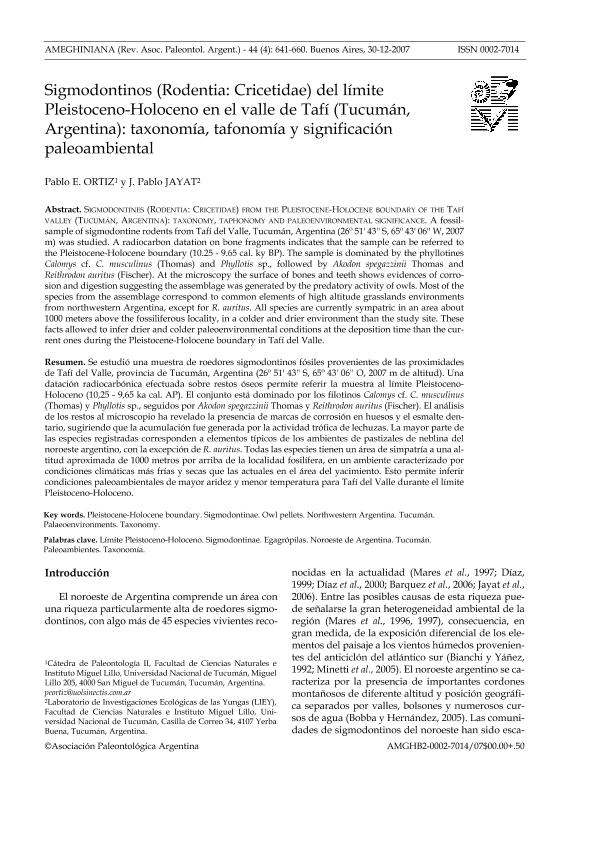Mostrar el registro sencillo del ítem
dc.contributor.author
Ortiz, Pablo Edmundo

dc.contributor.author
Jayat, Jorge Pablo

dc.date.available
2020-03-17T14:25:48Z
dc.date.issued
2007-12
dc.identifier.citation
Ortiz, Pablo Edmundo; Jayat, Jorge Pablo; Sigmodontinos (Rodentia: Cricetidae) del límite pleistoceno-holoceno en el valle de Tafí (Tucumán, Argentina): taxonomía, tafonomía y significación paleoambiental; Asociación Paleontológica Argentina; Ameghiniana; 44; 4; 12-2007; 641-660
dc.identifier.issn
0002-7014
dc.identifier.uri
http://hdl.handle.net/11336/99782
dc.description.abstract
A fossilsample of sigmodontine rodents from Tafí del Valle, Tucumán, Argentina (26º 51´ 43´´ S, 65º 43´ 06´´ W, 2007 m) was studied. A radiocarbon datation on bone fragments indicates that the sample can be referred to the Pleistocene-Holocene boundary (10.25 - 9.65 cal. ky BP). The sample is dominated by the phyllotines Calomys cf. C. musculinus (Thomas) and Phyllotis sp., followed by Akodon spegazzinii Thomas and Reithrodon auritus (Fischer). At the microscopy the surface of bones and teeth shows evidences of corrosion and digestion suggesting the assemblage was generated by the predatory activity of owls. Most of the species from the assemblage correspond to common elements of high altitude grasslands environments from northwestern Argentina, except for R. auritus. All species are currently sympatric in an area about 1000 meters above the fossiliferous locality, in a colder and drier environment than the study site. These facts allowed to infer drier and colder paleoenvironmental conditions at the deposition time than the current ones during the Pleistocene-Holocene boundary in Tafí del Valle.
dc.description.abstract
Se estudió una muestra de roedores sigmodontinos fósiles provenientes de las proximidades de Tafí del Valle, provincia de Tucumán, Argentina (26º 51' 43'' S, 65º 43' 06'' O, 2007 m de altitud). Una datación radiocarbónica efectuada sobre restos óseos permite referir la muestra al límite Pleistoceno-Holoceno (10,25 - 9,65 ka cal. AP). El conjunto está dominado por los filotinos Calomys cf. C. musculinus (Thomas) y Phyllotis sp., seguidos por Akodonspegazzinii Thomas y Reithrodonauritus (Fischer). El análisis de los restos al microscopio ha revelado la presencia de marcas de corrosión en huesos y el esmalte dentario, sugiriendo que la acumulación fue generada por la actividad trófica de lechuzas. La mayor parte de las especies registradas corresponden a elementos típicos de los ambientes de pastizales de neblina del noroeste argentino, con la excepción de R.auritus. Todas las especies tienen un área de simpatría a una altitud aproximada de 1000 metros por arriba de la localidad fosilífera, en un ambiente caracterizado por condiciones climáticas más frías y secas que las actuales en el área del yacimiento. Esto permite inferir condiciones paleoambientales de mayor aridez y menor temperatura para Tafí del Valle durante el límite Pleistoceno-Holoceno.
dc.format
application/pdf
dc.language.iso
spa
dc.publisher
Asociación Paleontológica Argentina

dc.rights
info:eu-repo/semantics/openAccess
dc.rights.uri
https://creativecommons.org/licenses/by-nc-sa/2.5/ar/
dc.subject
PALEONTOLOGÍA
dc.subject
SIGMODONTINAE
dc.subject
PALEOAMBIENTES
dc.subject
NOROESTE ARGENTINO
dc.subject.classification
Otras Ciencias Biológicas

dc.subject.classification
Ciencias Biológicas

dc.subject.classification
CIENCIAS NATURALES Y EXACTAS

dc.title
Sigmodontinos (Rodentia: Cricetidae) del límite pleistoceno-holoceno en el valle de Tafí (Tucumán, Argentina): taxonomía, tafonomía y significación paleoambiental
dc.title
Sigmodontines (rodentia: cricetidae) from the pleistocene-holocene boundary o fthe tafí valley (tucumán, argentina): taxonomy, taphonomy and paleoenvironmental significance
dc.type
info:eu-repo/semantics/article
dc.type
info:ar-repo/semantics/artículo
dc.type
info:eu-repo/semantics/publishedVersion
dc.date.updated
2020-03-11T18:29:26Z
dc.identifier.eissn
1851-8044
dc.journal.volume
44
dc.journal.number
4
dc.journal.pagination
641-660
dc.journal.pais
Argentina

dc.journal.ciudad
Buenos Aires
dc.description.fil
Fil: Ortiz, Pablo Edmundo. Consejo Nacional de Investigaciones Científicas y Técnicas. Centro Científico Tecnológico Conicet - Tucumán. Instituto Superior de Correlación Geológica. Universidad Nacional de Tucumán. Facultad de Ciencias Naturales e Instituto Miguel Lillo. Departamento de Geología. Cátedra Geología Estructural. Instituto Superior de Correlación Geológica; Argentina
dc.description.fil
Fil: Jayat, Jorge Pablo. Consejo Nacional de Investigaciones Científicas y Técnicas. Centro Científico Tecnológico - Tucumán. Unidad Ejecutora Lillo; Argentina
dc.journal.title
Ameghiniana

dc.relation.alternativeid
info:eu-repo/semantics/altIdentifier/url/http://www.ameghiniana.org.ar/index.php/ameghiniana/article/view/692/1432
Archivos asociados
